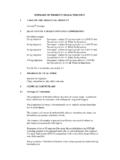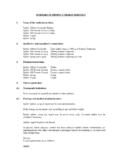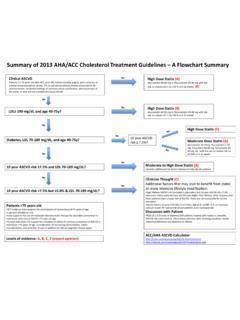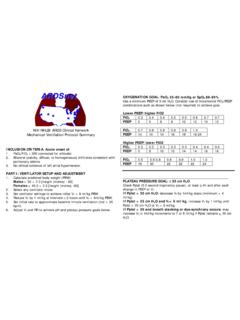Transcription of SUMMARY OF PRODUCT CHARACTERISTICS 1 …
1 SUMMARY OF PRODUCT CHARACTERISTICS 1 NAME OF THE MEDICINAL PRODUCT Targocid 200mg Teicoplanin 200mg Powder for Injection Targocid 400mg Teicoplanin 400mg Powder for Injection 2 QUALITATIVE AND QUANTITATIVE COMPOSITION Teicoplanin 200mg Teicoplanin 400mg 3 PHARMACEUTICAL FORM Powder for Injection 4 CLINICAL PARTICULARS Therapeutic indications Targocid is indicated in potentially serious Gram-positive infections including those which cannot be treated with other antimicrobial drugs, eg. penicillins and cephalosporins. Targocid is useful in the therapy of serious staphylococcal infections in patients who cannot receive or who have failed to respond to the penicillins and cephalosporins, or who have infections with staphylococci resistant to other antibiotics. The effectiveness of teicoplanin has been documented in the following infections:- Skin and soft tissue infections, urinary tract infections, lower respiratory tract infections, joint and bone infections, septicaemia, endocarditis and peritonitis related to continuous ambulatory peritoneal dialysis.
2 Targocid may be used for antimicrobial prophylaxis in orthopaedic surgery at risk of Gram-positive infection. Posology and method of administration Administration The reconstituted Targocid injection may be administered directly either intravenously or intramuscularly. The intravenous injection may be administered either as a bolus or as a 30 minute infusion. Only the infusion method must be used in neonates. Dosage is usually once daily but, in cases of severe infection, a second injection should be administered on the first day in order to reach more rapidly the required serum concentrations. The administration of teicoplanin by the intraventricular route is not indicated (see sections and ) The majority of patients with infections caused by organisms sensitive to the antibiotic show a therapeutic response within 48-72 hours. The total duration of therapy is determined by the type and severity of the infection and the clinical response of the patient.
3 In endocarditis and osteomyelitis, treatment for three weeks or longer is recommended. TARGOCID must not be administered for more than 4 months. Determination of teicoplanin serum concentrations may optimise therapy. In severe infections, trough serum concentrations should not be less than 10mg/l. Peak concentrations measured one hour after a 400mg intravenous dose are usually in the range of 20-50mg/l; peak serum concentrations of up to 250mg/l have been reported after intravenous doses of 25mg/kg. A relationship between serum concentration and toxicity has not been established. Therapeutic dosage: Adult or elderly patients with normal renal function Prophylaxis: 400mg intravenously as a single dose at induction of anaesthesia Moderate infections: Skin and soft tissue infection, urinary tract infection, lower respiratory tract infection Loading dose: One single or injection of 400mg on the first day Maintenance dose: A single or injection of 200mg daily Severe infections: Joint and bone infection, septicaemia, endocarditis Loading dose: Three 400mg injections, administered 12 hours apart Maintenance dose: A single or injection of 400mg daily 1.
4 Standard doses of 200 and 400mg equate respectively to mean doses of 3 and 6mg/kg. In patients weighing more than 85kg it is recommended to adapt the dosage to the weight following the same therapeutic schedule: moderate infection 3mg/kg, severe infection 6mg/kg. 2. In some clinical situations, such as infected, severely burned patients or Staphylococcus aureus endocarditis, unit maintenance doses of up to 12mg/kg have been administered (intravenously). In endocarditis caused by Staphylococcus aureus, satisfactory results have been achieved with teicoplanin in polytherapy. When serum concentrations are controlled in severe infections, the trough levels must be 10 times higher than the MIC or, generally, at least 10 mg/l. In the treatment of antibiotic-associated diarrhoea caused by Clostridium difficile: one oral dose of 200 mg twice a day. Children Teicoplanin can be used to treat Gram-positive infections in children from the age of 2 months. For severe infections and neutropenic patients the recommended dose is 10mg/kg every 12 hours for the first three doses; thereafter a dose of 10mg/kg should be administered by either intravenous or intramuscular injection as a single dose each day.
5 For moderate infections the recommended dose is 10mg/kg every twelve hours for the first three doses; thereafter a dose of 6mg/kg should be administered by either intravenous or intramuscular injection as a single dose each day. The recommended dosage regimen for neonates is a loading dose of 16mg/kg followed by a daily dose of 8mg/kg. The dose must be infused over 30 minutes. In continuous ambulatory periotoneal dialysis After a single loading IV dose of 400mg of the patient is febrile, the recommended dosage is 20mg/l per bag in the first week, 20mg/l in alternate bags in the second week and 20mg/l in the overnight dwell bag only during the third week, feverish patients must also take an loading dose of 400 mg of teicoplanin. Teicoplanin remains stable in solutions for peritoneal dialysis ( or dextrose). These solutions must not be kept for more than 24 hours. Combined treatment: It is recommended that the treatment be combined with an appropriate antibacterial agent when the infection requires a maximum antibacterial activity ( staphylococcal endocarditis) and when it cannot be ruled out that there is a mixed infection with gram-negatives ( empirical treatment of fever in a neutropenic patient).
6 Prophylaxis of endocarditis caused by gram-positives in dental surgery and in patients with heart valve disease: To induce anaesthesia, 400 mg (6 mg/kg) of teicoplanin. Adults and elderly patients with renal insufficiency For patients with impaired renal function, reduction of dosage is not required until the fourth day of Targocid treatment. Measurement of the serum concentration of teicoplanin may optimise therapy (see section Administration ). From the fourth day of treatment In mild renal insufficiency Creatinine clearance between 40 and 60ml/min, Targocid dose should be halved, either by administering the initial unit dose every two days, or by administering half of this dose once a day. In severe renal insufficiency Creatinine clearance less than 40ml/min and in haemodialysed patients, Targocid dose should be one third of the normal either by administering the initial unit dose every third day, or by administering one third of this dose once a day.
7 Teicoplanin is not removed by dialysis. Contraindications Teicoplanin is contra-indicated in patients who have exhibited previous hypersensitivity to the drug. Special warnings and precautions for use Warnings: Targocid should be administered with caution in patients known to be hypersensitive to vancomycin since cross hypersensitivity may occur. However, a history of the Red Man Syndrome that can occur with vancomycin is not a contra-indication to Targocid. Thrombocytopenia has been reported with teicoplanin, especially at higher doses than those usually recommended. It is advisable for periodic haematological studies to be performed during treatment. Liver and renal function tests are advised during treatment. Serial renal and auditory function tests should be undertaken in the following circumstances: Prolonged treatment in patients with renal insufficiency. Concurrent and sequential use of other drugs which may have neurotoxic and/or nephrotoxic properties.
8 These include aminoglycosides, colistin, amphotericin B, ciclosporin, cisplatin, furosemide and etacrynic acid. However, there is no evidence of synergistic toxicity with combinations with Targocid. Dosage must be adapted in patients with renal impairment (see Dosage ). Precautions: Superinfection: as with other antibiotics, the use of teicoplanin, especially if prolonged, may result in overgrowth of non-susceptible organisms. Repeated evaluation of the patient s condition is essential. If superinfection occurs during therapy, appropriate measures should be taken. In some cases of intraventricular use, seizures have been reported (see sections and ) Interaction with other medicinal products and other forms of interaction Targocid should be used with care in conjunction with or sequentially with other drugs with known nephrotoxic or ototoxic potential. These include aminoglycosides, amphotericin B, ciclosporin, and furosemide (see section ).
9 Of particular concern are streptomycin, neomycin, kanamycin, gentamicin, amikacin, tobramycin, cephaloridine, colistin. In clinical trials teicoplanin has been administered to many patients already receiving various medications including other antibiotics, antihypertensives, anaesthetic agents, cardiac drugs and antidiabetic agents without evidence of adverse interaction. Animal studies have shown lack of interaction with diazepam, thiopental, morphine, neuromuscular blocking agents or halothane. Pregnancy and lactation There are no adequate data from the use of teicoplanin in pregnant women. Studies in animals have shown reproductive toxicity at high doses (see section ). The potential risk for humans is unknown. Teicoplanin should not be used during pregnancy unless clearly necessary. It is not known whether teicoplanin is excreted in human breast milk. The excretion of teicoplanin in milk has not been studied in animals. A decision on whether to continue/discontinue breast-feeding or to continue/discontinue therapy with teicoplanin should be made taking into account the benefit of breast-feeding to the child and the benefit of teicoplanin therapy to the mother.
10 Effects on ability to drive and use machines Teicoplanin can cause dizziness and headaches. The ability to drive or use machines may be affected. Patients experiencing these undesirable effects should not drive or use machines. Undesirable effects Although causal relationships have not been established in every case, the following undesirable effects have been reported with the administration of teicoplanin: System organ class Very common ( 1/10) Common ( 1/100 to <1/10 ) Uncommon ( 1/1,000 to <1/100) Rare ( 1/10,000 to <1/1,000) Very rare (<1/10,000) Frequency not known (cannot be estimated from available data)* Infections and infestations Abscess Injection site abscess, superinfection (overgrowth of non-susceptible organisms) System organ class Very common ( 1/10) Common ( 1/100 to <1/10 ) Uncommon ( 1/1,000 to <1/100) Rare ( 1/10,000 to <1/1,000) Very rare (<1/10,000) Frequency not known (cannot be estimated from available data)* Blood and the lymphatic system disorders Eosinophilia, thrombocytopenia, leucopenia Agranulocytosis, neutropenia Immune system disorders Anaphylactic reaction (anaphylaxis) Anaphylactic shock Nervous system disorders Dizziness, headache Seizures with intraventricular use Ear and labyrinth disorders Deafness (mild hearing loss)










